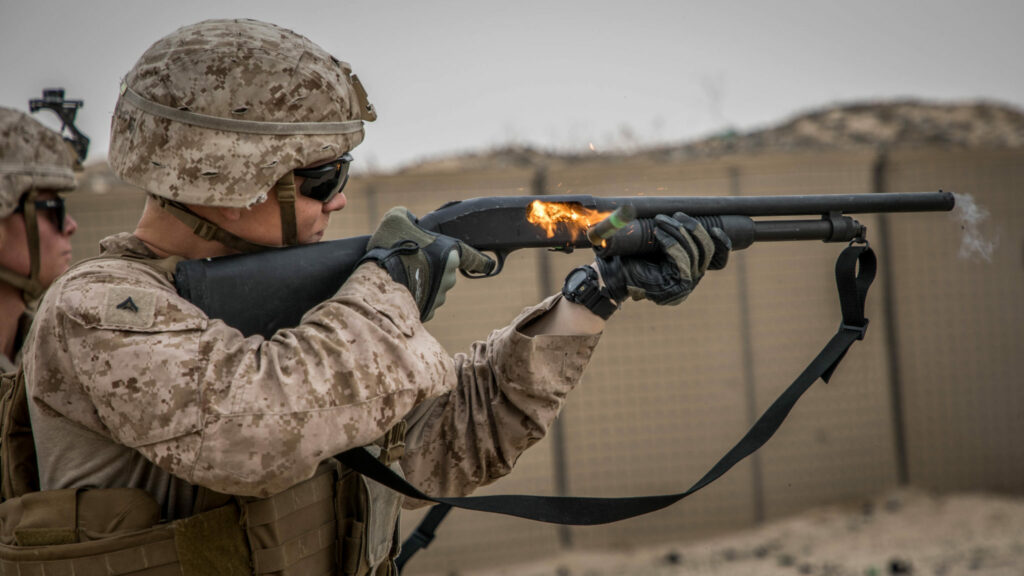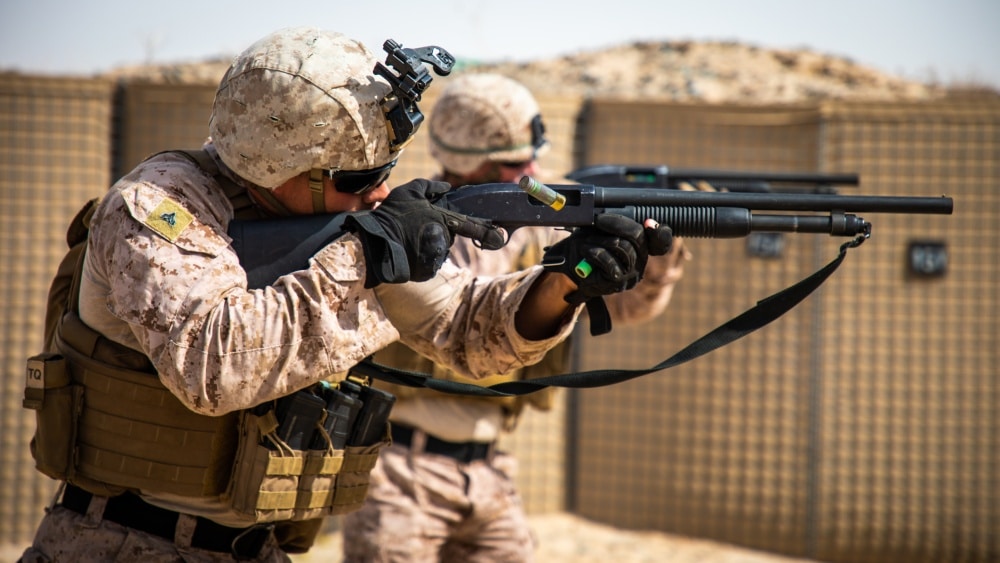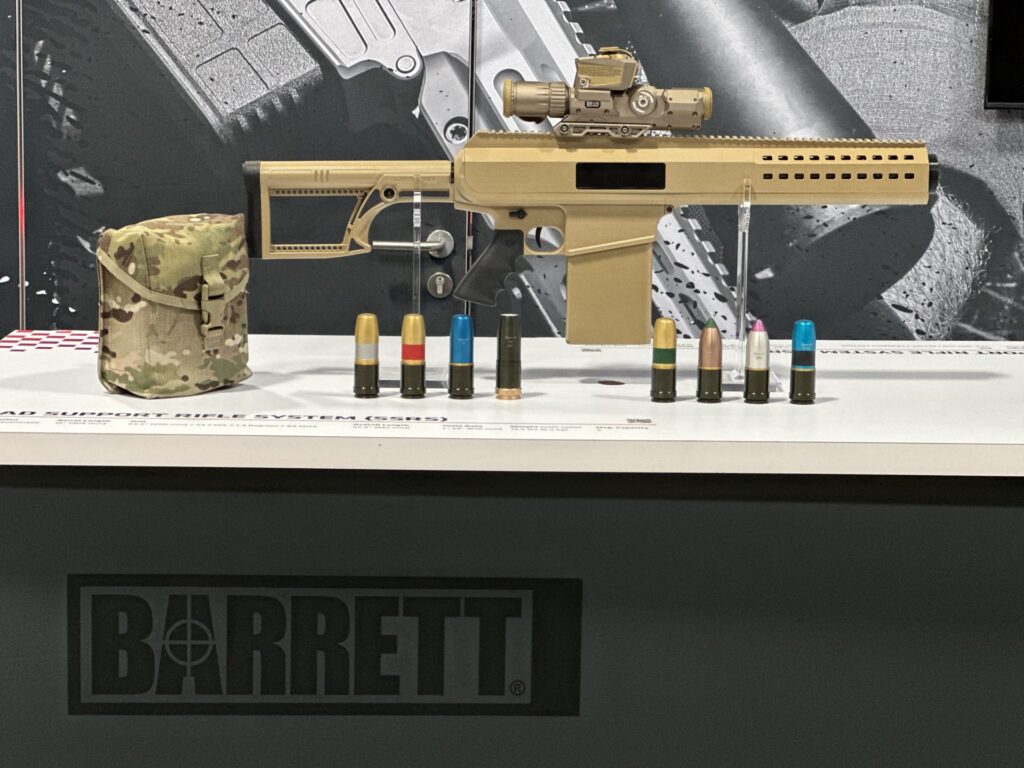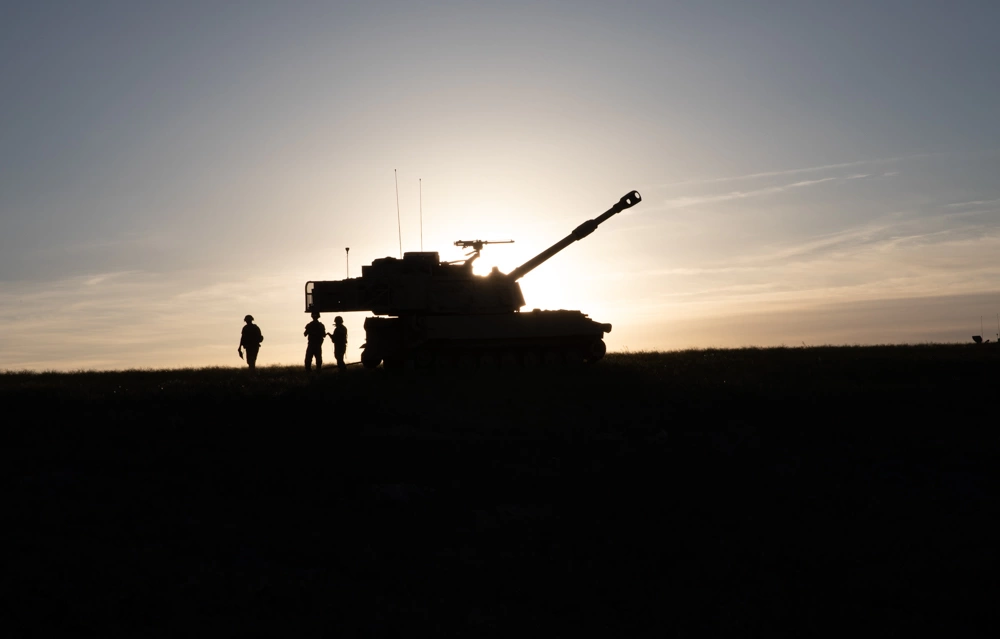The 590A1 fighting shotgun – The military’s pump-action option
- By Travis Pike
Share This Article

Shotguns are very niche weapons within the United States military; however, within their niche, they are impossible to beat. Pump-action shotguns have served since the 1890s and continue to this day. Over time, the United States military has used a wide variety of shotguns. In Vietnam, almost a dozen different shotguns served with various military forces. So, coming out of the Cold War, the military looked to standardize. The shotgun they standardized on was the Mossberg 590A1.
Standardization drives down cost, simplifies armories, and improves training efficiency among troops. Standardization also requires the shotgun to conform to the needs of all four branches, and that’s precisely what the Mossberg 590A1 was capable of doing. This is a pump-action shotgun, which means it requires a manual action between shots to accentuate the action and work the pump.
Why a pump action?
Shotguns come in nearly every configuration you could consider. We have semi-autos, lever actions, single and double barrels, bolt actions, and some I’m likely forgetting. The military uses the semi-auto and pump actions for their combative shotguns. Semi-auto actions make a lot of sense for combative shotguns, so why does the military use both semi-auto and pump actions?
Pump actions like the 590A1 stick around because of their versatility. Semi-auto shotguns work well with specific loads like buckshot and slugs, but pump actions work with a wide variety of loads. Shotguns can be highly versatile and function with a wide variety of loads. The 590A1 can use buckshot and slugs, but it can also function with underpowered loads like less lethal and breaching loads.

The pump-action design also allows the weapon to be quickly manipulated and gives the shooter faster follow-up shots. Compared to other manual action options like bolt and lever, the pump action is extraordinarily ergonomic and works well with bulk shotgun ammunition. Bolt actions tend to be slow, and a lever-action has a very long throw due to the ammo’s size and bulk.
What’s the 590A1?
So we know the 590A1 is a pump-action shotgun, but there is more to it than that. The 590A1 is directly related to the Mossberg 500 series. The Mossberg 500 series was introduced in 1960 and utilized a design from Carl Benson. They were designed to be an affordable option for pump-action shotguns. 500 series shotguns use a fixed tubular magazine that is mounted beneath the barrel and loaded through the shotgun’s loading port.
Mossberg reduced costs by utilizing an aluminum receiver instead of a steel receiver. This also reduced the shotgun’s weight without noticeably decreasing durability. Modern Mossbergs use dual-action bars that increase reliability. The dual-action bars have generous clearances that help the gun resist wear and allow it to function with dirt and debris present.
Related: The craziest shotguns ever designed for the US military

The 590 series of shotguns changed the barrel and magazine profile to be more combat-oriented. The 590 series were produced specifically to address some weaknesses with the Mossberg 500 series for police and military work. The 590A1 further made changes to the 590 series to address specific needs of the United States military.
What sets the 590A1 apart
The first significant change the military requested was the removal and replacement of the polymer trigger group and safety. In their place, Mossberg installed more formidable aluminum options to reduce the risk of breakage.
Additionally, the Navy requested a heavier, thicker-walled barrel that would resist bending if caught in the heavy metal doors of a Naval ship. Finally, a bayonet lug was added, and I always joke that the bayonet was a requirement of the Marine Corps. However, bayonet lugs are commonplace. This became such a novel feature that Mossberg now includes it on the standard 590 series shotguns.

The 590A1 varies in barrel length, magazine capacity, and sighting options. Some models feature 14-inch barrels with five-round magazine tubes. Others feature 18.5- and 20-inch barrels with capacities of up to eight rounds. Sighting systems include ghost ring sights with a rifle front sight or a simple bead sight.
Related: Can this Navy patent explain away many UAP sightings?
What are they used for?
The 590A1 is a purpose-built combat shotgun, and as such, it excels in close-quarters combat. Shotguns fire a load of shot, which is several pellets of shot. The military’s 00 load of buckshot fires nine .33 caliber pellets per trigger pull. These loads of shot are only effective at close ranges, and in that role, they excel.
Marines famously utilized shotguns extensively during Fallujah and during most of the urban warfare in Iraq. The loads of shot allow for decisive one-shot stops on threats at close range. In this niche role, shotguns do well but will never fully replace the rifle or carbine.

Pump-action shotguns like the Mossberg 590A1 can also function with less-lethal rubber buckshot, rubber slugs, and non-lethal beanbag rounds. These loads are very lightly loaded and will not cycle in a semi-auto shotgun. However, the manual action of a pump-action shotgun allows troops to engage with non-lethal loads without interruption rapidly.
Additionally, shotguns excel for breaching doors. When you need to get through a door, a shotgun can blow through a door’s lock or take off the hinges. Further, specialized breaching load will not cycle in a semi-auto shotgun but will work fine in a pump action.
The fighting 590A1
The Mossberg 590A1 is the only pump shotgun that passed the United States Army’s Mil-Spec 3443E test. This test involves drops, falls, and over 3,000 rounds of full-powered buckshot. The 590A1 took it without issue and kept coming back. When the military needed a pump-action shotgun built from the ground up to fit its needs, the 590A1 answered the call.
In its niche, there is no better option for the American fighting man.
Read more from Sandboxx News
Related Posts
Sandboxx News Merch
-

‘AirPower’ Classic Hoodie
$46.00 – $48.00 Select options This product has multiple variants. The options may be chosen on the product page -

‘Sandboxx News’ Trucker Cap
$27.00 Select options This product has multiple variants. The options may be chosen on the product page -

‘Kinetic Diplomacy’ Bumper Sticker (Black)
$8.00 Add to cart

Travis Pike
Travis Pike is a former Marine Machine gunner who served with 2nd Bn 2nd Marines for 5 years. He deployed in 2009 to Afghanistan and again in 2011 with the 22nd MEU(SOC) during a record-setting 11 months at sea. He’s trained with the Romanian Army, the Spanish Marines, the Emirate Marines, and the Afghan National Army. He serves as an NRA certified pistol instructor and teaches concealed carry classes.
Related to: Gear & Tech

5 ways to prepare and survive the Marine Corps boot camp

Barrett’s Squad Support Rifle System will make infantry squad deadlier

The unique world and uses of howitzers
Sandboxx News
-

‘Sandboxx News’ Trucker Cap
$27.00 Select options This product has multiple variants. The options may be chosen on the product page -

‘AirPower’ Classic Hoodie
$46.00 – $48.00 Select options This product has multiple variants. The options may be chosen on the product page -

‘AirPower’ Golf Rope Hat
$31.00 Select options This product has multiple variants. The options may be chosen on the product page -

‘Sandboxx News’ Dad Hat
$27.00 Select options This product has multiple variants. The options may be chosen on the product page
